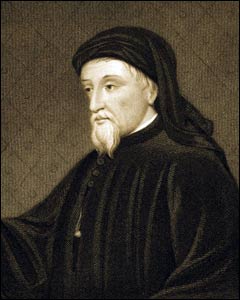07.12

On July 12, 1389, King Richard II appoints Geoffrey Chaucer to the position of chief clerk of the king’s works in Westminster on this day in 1389. Chaucer, the middle-class son of a wine merchant, served as a page in an aristocratic household during his teens and was associated with the aristocracy for the rest of his life. In 1359, he fought in France with Edward III, and was captured in a siege. Edward III ransomed him, and he later worked for Edward III and John of Gaunt. One of his earliest known works was an elegy for the deceased wife of John of Gaunt, Book of the Duchesse. In 1372, Chaucer traveled to Italy on diplomatic missions, where he may have been exposed to Dante, Petrarch, and Boccaccio. He also visited Flanders and France, and was appointed comptroller of customs. He wrote several poems in the 1380s, including The Parlement of Foules and Troilus and Criseyde. In the late 1380s or early 1390s, he began work on the Canterbury Tales, in which a mixed group of nobles, peasants, and clergy make a pilgrimage to the shrine of Thomas a Becket in Canterbury. The work, a compilation of tales told by each character, is remarkable for its presentation of the spectrum of social classes. Although Chaucer intended the book to include 120 stories, he died in 1399, with only 22 tales finished.











